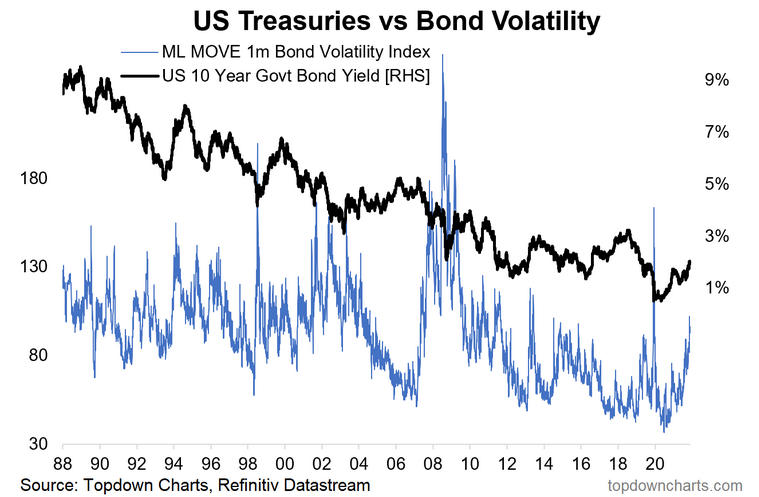This post was originally published at TopDown Charts
Bond market sentiment is reaching extreme levels
Treasury volatility, as measured by the MOVE Index, spiked to very high readings
We see intermediate-term fixed-income rates near fair value for now
It’s not just stock market volatility that is rattling the market’s nerves. Big moves in Treasuries and other global sovereign bond markets have traders on edge. There is a lot to digest right now. The risk of higher inflation pressures the US Federal Reserve to act fast to raise rates. If they hike too aggressively, the Treasury yield curve will invert (which, of course, carries with it the narrative of an imminent recession). Finally, as we all watch, the Russia-Ukraine invasion risk is front and center.
Big Selling, then Panic Buying
What are bond traders to do? They are modestly selling risky fixed-income securities, such as high-yield debt and some investment grade bonds. They also have bid up the 10-year Treasury note so that its yield dipped to 1.85% early Monday morning before a climb back near 2% on Wednesday. Some of these moves are making traders’ heads spin.
We find that yields are showing signs of exhaustion. Bond market sentiment is hitting extreme (and even contrarian) readings while volatility in fixed income suggests we are in the late innings of a big move. That’s not to say that yields are going to crater and never recover, but perhaps we are near a point of consolidation after a huge rise in rates.
Analyzing the ML MOVE Index: A Treasury Volatility Gauge
Digging deeper into the volatility aspect, the Merrill Lynch MOVE Index measures volatility using 1-month Treasury options which are weighted on the 2-, 5-, 10-, and 30-year contracts. Historically, the MOVE Index jumps when interest rates rise sharply—that makes sense because higher rates means Treasury market selling. Often traders rush for the exits faster than when buying happens.
The featured chart below illustrates how quickly the Treasury market went from relative calm to high anxiety. The ML MOVE Index has reached its highest level since the 2013 Taper Tantrum (sans the Covid spike). Is history repeating itself? Is much of the rise in rates done with?
Featured Chart: Bond Market Volatility Jumps as the US 10 Year Rate Climbs

Risks Not Done: It Is a Mid-Term Year, Of Course
We still have a longer-term bearish outlook on bonds, but we acknowledge that a period of consolidation makes sense right now. Historically, the March-April period is often strong for risk assets before a bearish turn in late Q2 and Q3. Mid-term years in particular tend to see volatility increase in the months leading up to the election. Maybe the next bout of interest rate increases comes a bit later.
Bottom Line: Bond market sentiment is reaching bearish extremes, which is consistent with a bullish reversal signal. The move higher in rates could be at exhaustion. The ML MOVE Index indeed shows that it's rare to see Treasury market volatility sustain itself at these levels. Our macro/market composite model is close to matching where intermediate-term sovereign rates are now (after years of a major gap). We see risks for Treasury yields more balanced today.
